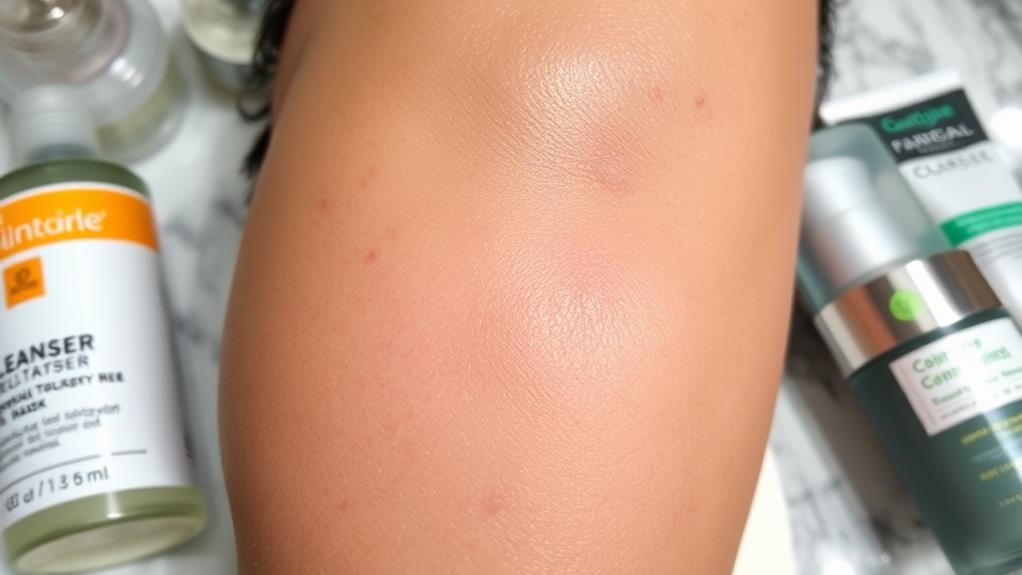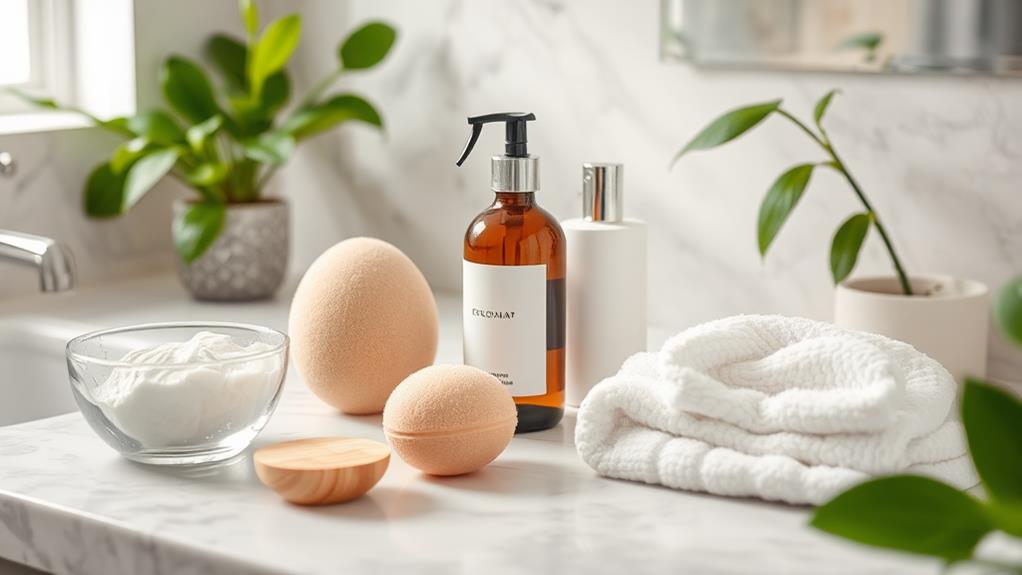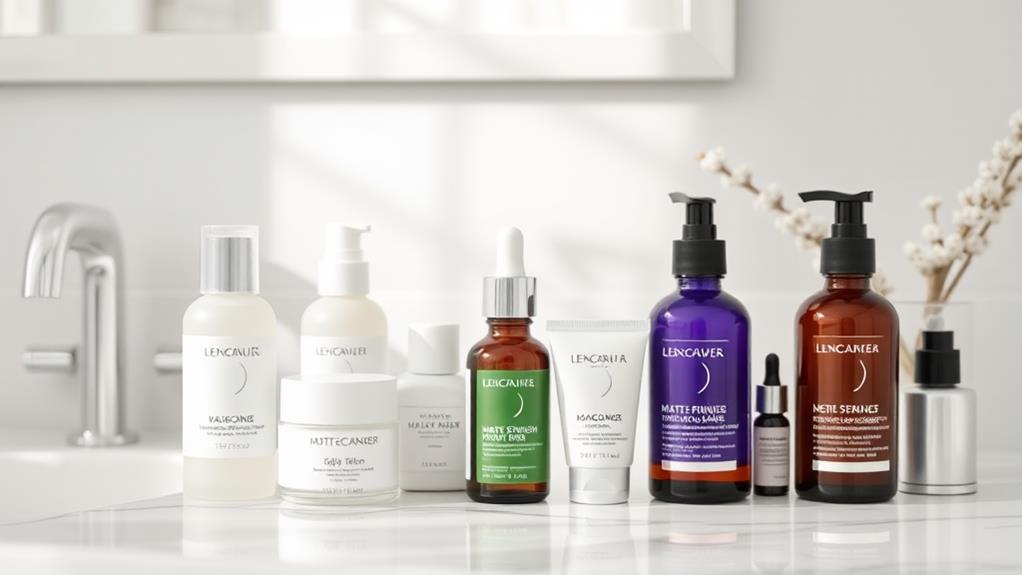If you have oily skin, you know how challenging it can be to find a skincare routine that actually works. You might be overwhelmed by the countless products claiming to control shine and prevent breakouts. It's essential to start with the right cleansing methods and follow up with effective treatments tailored to your skin's needs. But what specific steps should you take to guarantee your routine is both effective and manageable? Let's explore some key elements that can make a significant difference in your skincare journey.
Understanding Oily Skin

Understanding oily skin begins with recognizing the underlying causes and characteristics that define it. Oily skin is primarily a result of overactive sebaceous glands, which produce excess sebum. This can lead to a shiny appearance and increased likelihood of acne breakouts.
One common misconception is that oily skin doesn't require moisturizing. In reality, even oily skin needs hydration to maintain balance; neglecting this can trigger more oil production.
Hormonal influences also play an important role in the behavior of your skin. Fluctuations in hormones, particularly during puberty, menstruation, or pregnancy, can exacerbate oiliness. Androgens, a group of hormones, stimulate sebaceous glands to produce more oil, making it essential to understand your hormonal cycles when managing oily skin.
Another misconception is that harsh cleansers will solve oiliness. While they may strip away sebum temporarily, they can lead to increased oil production in the long run.
Instead, an evidence-based approach involves using gentle, non-comedogenic products that effectively manage oil without causing irritation. By clearing up these myths and understanding the science behind oily skin, you can develop a more effective skincare strategy tailored to your needs.
Essential Cleansing Steps
A proper cleansing routine is essential for managing oily skin effectively. To start, consider your cleansing frequency. Dermatologists recommend cleansing your face twice a day—once in the morning and once before bed. This helps remove excess oil, impurities, and bacteria that can lead to breakouts. If you've been sweating or wearing makeup, you might need to cleanse more often to prevent clogged pores.
Next, focus on product selection. Opt for a gentle foaming or gel cleanser containing salicylic acid or benzoyl peroxide, as these ingredients help control oil production and combat acne. Avoid harsh soaps that can strip your skin of its natural oils, leading to a rebound effect where your skin produces even more oil.
Always follow up with a toner to balance your skin's pH and further remove residual impurities.
Exfoliation Techniques

How can you effectively incorporate exfoliation into your skincare routine for oily skin?
Exfoliation is essential for managing excess oil, preventing clogged pores, and promoting a brighter complexion. You can choose between two primary techniques: chemical exfoliants and physical scrubs.
Chemical exfoliants, such as alpha-hydroxy acids (AHAs) and beta-hydroxy acids (BHAs), work by dissolving dead skin cells and excess sebum on a molecular level. Salicylic acid, a common BHA, penetrates deep into pores, making it particularly effective for oily skin.
Aim to use chemical exfoliants two to three times per week to maintain skin health without over-exfoliating.
On the other hand, physical scrubs involve manually sloughing off dead skin cells using gritty particles. While they can provide immediate smoothness, you must be cautious with their use. Over-scrubbing may irritate the skin and exacerbate oiliness.
If you opt for physical scrubs, choose gentle formulas with natural exfoliants like sugar or oatmeal and limit their use to once a week.
Balancing these exfoliation techniques will help you achieve clearer skin while keeping oil production in check.
Choosing the Right Moisturizer
Selecting the right moisturizer is essential for maintaining balanced skin, especially when dealing with oily skin types. The goal is to hydrate your skin without adding excess oil or clogging pores. To achieve this, you should consider specific moisturizer types that cater to your skin's unique needs.
Here are some hydration tips to help you choose wisely:
- Opt for lightweight, oil-free formulas: Gel-based moisturizers often provide hydration without the heaviness of creams, making them ideal for oily skin.
- Look for non-comedogenic products: These are specifically designed not to clog pores, reducing the risk of breakouts while ensuring you receive necessary moisture.
- Consider ingredients like hyaluronic acid: This powerful humectant draws moisture into your skin, helping to keep hydration levels balanced without adding excess oil.
Recommended Treatments and Ingredients

Finding the right moisturizer is just one piece of the puzzle when managing oily skin. To effectively address excess oil production, consider incorporating treatments and ingredients that are scientifically proven to help.
Salicylic acid is a standout; it penetrates pores, exfoliates, and helps reduce acne. Look for products containing this ingredient, as they can be effective in controlling breakouts.
Another potent option is niacinamide. This ingredient not only regulates oil but also improves skin texture and minimizes the appearance of pores. You'll find it in serums and moisturizers, making it easy to integrate into your routine.
For those interested in natural remedies, tea tree oil is known for its antibacterial properties. Dilute it before application to avoid irritation. Aloe vera is also beneficial for oily skin; its soothing properties can reduce inflammation while providing lightweight hydration.
When selecting products, opt for non-comedogenic labels to prevent pore blockage. Brands like Neutrogena and Paula's Choice offer effective formulations that cater to oily skin.
Daily and Nightly Routines
A consistent daily and nightly skincare routine is vital for managing oily skin effectively.
In the morning, your habits should focus on controlling excess oil while providing hydration. Start with a gentle cleanser containing salicylic acid to remove impurities without stripping your skin. Follow up with a lightweight, oil-free moisturizer and a broad-spectrum sunscreen to protect against UV damage.
For your evening rituals, cleansing is essential. Use a foaming or gel cleanser to remove makeup and excess oil accumulated throughout the day. Incorporate a treatment containing retinol or niacinamide to help regulate oil production and minimize pores. Finish with a non-comedogenic moisturizer to maintain hydration overnight.
Consider the following key points to enhance your routine:
- Consistency: Stick to your regimen daily for best results.
- Patch Testing: Always test new products to avoid adverse reactions.
- Adaptability: Modify your routine based on season and skin condition changes.
Conclusion
Incorporating a consistent skincare routine tailored for oily skin can transform your complexion. By cleansing effectively, exfoliating regularly, and selecting the right moisturizer, you can manage oil production, enhance texture, and prevent breakouts. Utilizing targeted treatments like niacinamide or retinol can further elevate your results. Remember, it's about balance—balancing hydration with oil control, balancing treatment with prevention. Stay committed to your routine, and your skin will thank you with clarity and vibrancy.













